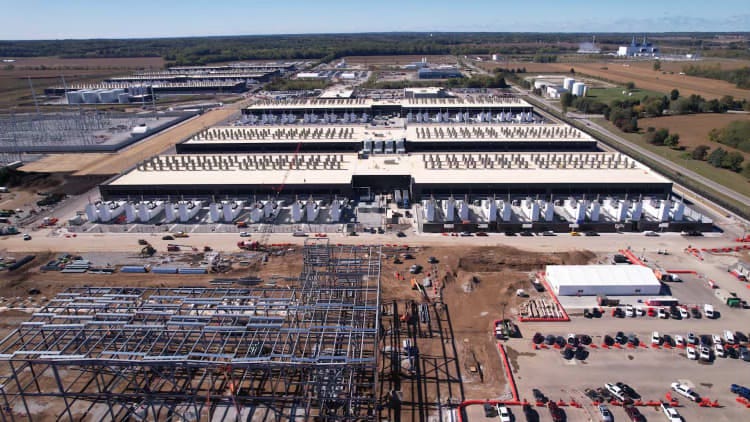Leaked memo shows Amazon planned to keep the full extent of its data centers’ water use out of public view.
According to the documents obtained by The Guardian (with SourceMaterial), Amazon’s cloud arm (AWS) discussed reporting only a narrow “primary” water number for optics.
“Shocking” on purpose: the disclosure plan—and the real number
According to the documents obtained by The Guardian (with SourceMaterial), Amazon’s cloud arm (AWS) discussed reporting only a narrow “primary” water number for optics—while excluding the much larger “secondary” water tied to electricity generation and supply chains. Internally, Amazon’s total water use in 2021 was estimated at about 105 billion gallons. The Guardian
What does 105 billion gallons mean in human terms? Using EPA’s benchmark that a U.S. household uses a bit over 300 gallons per day at home, that’s roughly ~959,000 households for a full year—nearly a million homes’ worth of water. Even wire services summarizing the leak pegged it at “about 958,000 U.S. households.” Amazon says the memo is outdated and points to a “water positive by 2030” goal, but it still doesn’t publish a single consolidated figure comparable to that internal estimate.
Meanwhile: a record U.S. data-center buildout
The context makes that disclosure strategy even more consequential. Across North America’s top markets, data-center capacity under construction surged to 5.24 GW in H1 2025 (up ~62% from late-2023), with Northern Virginia still the epicenter—but the boom is expanding well beyond the coasts. Eighteen facilities broke ground in July 2025 alone; 125 projects have started this year and 212 over the trailing 12 months, with record monthly spend and megaprojects queued up in the Midwest and Mid-Atlantic.
A Business Insider analysis puts a fine point on the scale: 54 new facilities were permitted in Virginia in the first nine months of 2025 (Amazon behind roughly half), part of a national wave of ~370 hyperscale sites. Hyperscale means huge—40 MW+ each—and when these campuses come in clusters, the combined water and power draw can rival U.S. states.
The heartland is next—and that’s where we grow food
The buildout is moving into America’s farm states. A Midwestern policy brief (Council of State Governments) compiles utility and market forecasts showing steep growth in “AI-ready” capacity by 2028:
Chicago: from 66 → 122 data centers (capacity 997 MW → 1,839 MW)
Columbus, OH: 40 → 85 ( 914 MW → 1,627 MW)
Des Moines, IA: 27 → 48 ( 712 MW → 1,286 MW)
Omaha, NE: 38 → 46 ( 1,233 MW → 1,798 MW)
The same brief flags the obvious: these facilities “can require millions of gallons per day” for cooling.
Why farmers and ranchers should care
Competition for the same water. Cities often promise potable or groundwater supplies to lure data centers. In water-short basins, that can tighten allocations for irrigation districts or drive rate hikes that hit producers. (Midwest utilities are already redesigning tariffs and infrastructure charges to serve massive new loads.)
Hidden, off-site water. Even “air-cooled” data centers have a big indirect water footprint through the power plants that make their electricity. Industry averages put on-site Water Usage Effectiveness (WUE) around ~1.8–1.9 liters per kWh—but that doesn’t count the water consumed to generate electricity. That’s exactly the part the Amazon memo proposed keeping out of the headline number. Translation: local impacts can be larger than the on-site figure suggests.
Drawdowns raise operating costs. Across the West and Southwest, satellite-based studies show accelerating groundwater depletion, particularly in the Lower Colorado River Basin. Falling water tables force deeper pumping—meaning more horsepower, more electricity, and higher bills for farms and feedlots. As industrial and municipal loads grow (including data-center clusters and chip plants), the competition intensifies.
Can this be done without squeezing food production?
Yes—if communities insist on the right guardrails up front.
Full-footprint transparency. Don’t accept WUE or “water positive” slogans alone. Require disclosure of total water footprint: on-site + power-supply water + seasonality + source (potable vs. reclaimed). This avoids the kind of cherry-picking the Amazon memo contemplated.
Source choice & drought modes. Favor air-cooled or hybrid systems in drought seasons and forbid summer peaking with evaporative cooling during irrigation-critical windows. Reclaimed/effluent supplies should be default, not exception. (Utah’s Eagle Mountain now reuses data-center process water to irrigate parks—a model worth copying for ag uses where feasible.)
No-impairment clauses for ag rights. Tie permits to guarantees that senior irrigation rights aren’t impaired in shortage years; require offsets such as aquifer storage & recovery (ASR) or permanent rights transfers when siting in stressed basins. (Midwestern planners already warn of “millions of gallons per day” cooling loads—plan like it.)
Cumulative-impact siting. Regional approvals should model all withdrawals (ag, municipal, industrial) plus the water embedded in the local power mix. It’s the only honest way to weigh siting a 200-MW campus next to irrigated acreage.
To Put It In Simple Terms
The leak matters because it shows how a tech giant intended to shape the story of water at the exact moment these facilities push into the nation’s food-producing regions. If the public underestimates the true water footprint, farms and ranches will feel the squeeze first.
The buildout is real, fast, and increasingly Midwestern—right in the heart of U.S. corn, soy, cattle, hogs, and dairy. Without transparency and farm-first guardrails, today’s AI boom becomes tomorrow’s input-cost spike and acreage risk.




